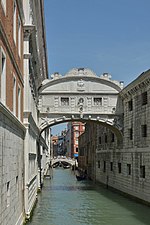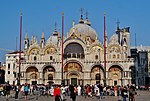Riva degli Schiavoni

The Riva degli Schiavoni is a waterfront area in Venice, Italy. There is a lively—albeit often overcrowded—promenade along the waterfront, which sits on St. Mark's Basin. It was originally built in the ninth century from dredged silt and was named for the Slavic men who brought cargo to Venice from across the Adriatic Sea. Many of the boats and launches that ferry tourists from the mainland and cruise ships stop at the Riva to allow passengers to disembark close to Piazza San Marco. There are other landmarks named after the early Slav merchants such as Palazzo Schiavoni, Scuola di San Giorgio degli Schiavoni, and a naval detachment of oltremarini, a mercenary group of Slavs either from the Montenegrin or Dalmatian litoral who as uskoks decided to join the Republic of Venice and fight a common enemy in the Candian Wars. Also, today Schiavone is a common Italian surname. In Italian schiavona is a basket-hilted sword.
Excerpt from the Wikipedia article Riva degli Schiavoni (License: CC BY-SA 3.0, Authors, Images).Riva degli Schiavoni
Riva degli Schiavoni, Venice Venezia-Murano-Burano
Geographical coordinates (GPS) Address Nearby Places Show on map
Geographical coordinates (GPS)
| Latitude | Longitude |
|---|---|
| N 45.4338 ° | E 12.3419 ° |
Address
Palazzo Dandolo
Riva degli Schiavoni
30120 Venice, Venezia-Murano-Burano
Veneto, Italy
Open on Google Maps










